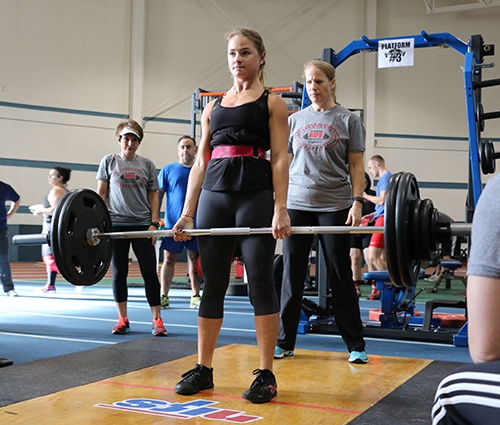 The deadlift is a creature all its own. There is no other exercise like it, and there are so many reasons behind that. It can be one of the most beneficial total-body exercises, yet at the same time, one of the most detrimental if performed incorrectly. Numerous factors go into this very important lift, but there are a few tricks to keep in mind to help you set up and perform well consistently while avoiding injury.
The deadlift is a creature all its own. There is no other exercise like it, and there are so many reasons behind that. It can be one of the most beneficial total-body exercises, yet at the same time, one of the most detrimental if performed incorrectly. Numerous factors go into this very important lift, but there are a few tricks to keep in mind to help you set up and perform well consistently while avoiding injury.
1. A straight line is the fastest path to your destination.
The deadlift starts at the floor and ends at a fully upright stance. There are no two ways about that. Isn’t the quickest way from point A to point B a straight line? Absolutely. This means that the path of the bar during the lift should be as straight as possible. If you’re saying “I have no idea whether my bar path is straight,” take a quick video of your deadlift from the side. A great smartphone app for this is Iron Path. It lets you track your bar path, and it has definitely helped me out.
2. Learn how to breathe and use a belt.
People ask whether they should wear a belt. There is no one-size-fits-all answer here. It completely depends on why you are wearing a belt in the first place. Contrary to popular belief, wearing a lifting belt will not save your back from bad deadlifting. Bad deadlifting (for example, rounding of the back) will place a lot of torque on your entire spine, and this is why most deadlifting injuries occur. A belt is not your safety net. The proper use for a belt is to, along with proper breathing, help create intra-abdominal pressure to brace the midsection for a heavy lift.
First, learn to breathe correctly. If the lift is heavy (80% or greater of your 1-rep max), you will want to take in a big breath before every rep and brace your abdominals and obliques to maintain spinal alignment. Once you can deadlift with proper breathing, a belt becomes helpful during your heavy lifts.
3. Determine your best stance.
I can’t tell you what your best stance is. You will have to find out on your own. The two traditional stances used are conventional and sumo stance. With conventional, your feet will be somewhere around shoulder width apart. With sumo stance, your feet will be much wider (typically 6 to 8 inches outside shoulder width). Certain body types tend to work better for each style. For example, someone who is considered to be tall and lanky might have a good chance of being a better conventional-style deadlifter. Certain limb lengths create different leverages that give advantages and disadvantages with each style of deadlifting. Long story short: try both.
***
Done correctly, the deadlift is one of the best overall exercises out there. It is a closed-chain, multi-joint movement that involves lower- as well as upper-body strength, stability, and mobility. Warning: the deadlift is not easy, and you may have to lighten up the weight to get the correct technique. Give these tips a try and make sure you ask a NIFS Health Fitness Specialist for more help with technique and how to better yourself as an athlete.
This blog was written by Aaron Combs, NSCA CSCS and Health Fitness Instructor. To find out more about the NIFS bloggers, click here.

